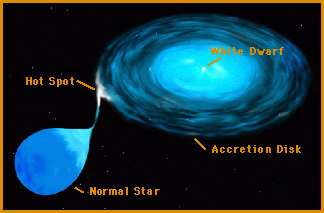Cataclysmic Variables
Introduction to Cataclysmic Variables (CVs)
Cataclysmic variables (CVs) are binary star systems that have a white dwarf and a normal star companion. They are typically small – the entire binary system is usually the size of the Earth-Moon system – with an orbital period of 1 to 10 hours. The white dwarf is often referred to as the "primary" star, and the normal star as the "companion" or the "secondary" star. The companion star, a star that is "normal," like our Sun, loses material onto the white dwarf via accretion. Since the white dwarf is very dense, the gravitational potential energy is enormous, and some of it is converted into X-rays during the accretion process. There are probably more than a million of these cataclysmic variables in the galaxy, but only those near our Sun (several hundreds) have been studied in X-rays so far. This is because CVs are fairly faint in X-rays; they are just above the coronal X-ray sources and far below the X-ray binaries in terms of how powerful their X-ray emissions are.

Classical Novae and Dwarf Novae
Optical astronomers discovered CVs based on their outbursts in the middle of the 19th century. CVs are classified into subclasses according to the properties of the outbursts: classical novae and dwarf novae. Classical novae are seen to erupt once, and the amplitude of the outburst is the largest among CVs. Classical nova outbursts are caused by sudden nuclear fusion of hydrogen-rich material on the surface of the white dwarf. Because white dwarfs are the cinders of stars like the Sun, hydrogen fusion is possible only when fresh fuel is accreted onto its surface.

Dwarf novae outbursts result from temporary increases in the rate of accretion onto the white dwarf, caused by the additional material accreted onto the surface. This material must go through a violent transition region called the "boundary layer", which lies just above the surface of the white dwarf. Dwarf novae outbursts are smaller in amplitude and higher in frequency than classical novae. The variable star U Geminorum, or "U Gem," is the prototype of dwarf novae. The brightness in the visible light of U Gem increases by a hundredfold every 120 days or so, and returns to the original level after a week or two.
Optical astronomers have also recognized "recurrent novae," which are eruptive behaviors that fall between the definitions of classical and dwarf novae, and "nova-like systems," which are stars that have similar spectra to other types of CVs in the visual light, but have not been seen to erupt.
X-ray Emission from CVs
Some X-ray sources detected by Uhuru turned out to be CVs; later on, the Einstein observatory observed many CVs to be weak X-ray sources. This is not surprising, as the accreting matter can easily reach temperatures of 100 million degrees or so near the white dwarf surface. Studies of CVs in X-rays therefore reveal the details of the accretion process near the primary. In the majority of CVs, accretion proceeds via an accretion disk. This occurs because the material leaving the secondary has angular momentum from the binary motion and, therefore, accretion cannot take place in a straight line. Rather, a disk-like structure is formed in the plane of the binary orbit (i.e., an accretion disk). Friction within the disk heats up the accreting material, and forces the material to gradually spiral down onto the white dwarf surface. Scientists think the X-rays in these CVs primarily come from the boundary layer which lies just above the surface of the white dwarf. This boundary layer marks where the velocity of the gas in the disk is forced to match the rotation velocity of the white dwarf.

However, most of the strongly X-ray emitting CVs turn out to have a magnetic white dwarf primary (some are known to have a magnetic field more than a hundred million times stronger than that of Earth). Since the accreting material is ionized, this magnetic field can control the flow. The geometry of accretion is very different in these magnetic CVs. Accretion disks are truncated or absent, so "column" and "curtain" are two words used to describe the geometry near the surface. In these cases, accretion is closer to vertical, along the magnetic field lines, which results in a stronger shock and stronger X-ray emission than when the accretion is via a disk. Magnetic CVs have been discovered mostly through their X-ray emission over the last 30 years.
In some cases, nuclear fusion, rather than accretion, can become the dominant energy source in a CV. The case of the classical nova outburst has been mentioned above. In addition, X-ray astronomers have discovered a class of objects called the "super-soft sources" (or SSS): the name derived from the X-ray spectrum of these systems, which is dominated by soft (lower energy) X-ray photons, typically below 0.5 keV. Detailed studies of the spectra of these SSS have revealed that they have the characteristic of X-rays from the hot (T ~ 200,000 - 800,000K), high gravity (g ~ 1,000,000 m/s/s) surface of a star. Such high gravity implies a white dwarf more massive than our Sun, which has its own implications.
White dwarf supernovae
Though some matter is ejected during a nova, some may also be retained, so the accretion/nova cycle can still allow for the dwarf's mass to increase. This mass gain could eventually result in the dwarf reaching the Chandrasekhar limit of 1.4 solar masses. As it approaches that limit, pressure builds and the internal temperature rises enough for carbon fusion to begin. The majority of white dwarfs are composed mostly of carbon, and when this fusion occurs, all the carbon undergoes fusion instantly. The result is a white dwarf supernova.
Last Modified: December 2010
Additional Links
- Quiz me about this topic
- Cool fact about this topic
- FAQs on binary stars
- FAQs on white dwarfs and other stars
- Additional resources


